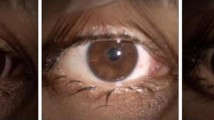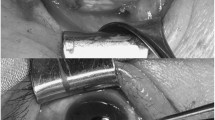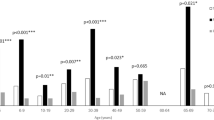Abstract
Background
To evaluate which factors predispose to an intraoperative conversion to the usual limbal approach in minimally invasive strabismus surgery (MISS).
Methods
This study included 451 consecutive patients operated on by one surgeon at Kantonsspital St Gallen, Switzerland, with minimally invasive rectus muscle surgery between February 2003 and December 2007. We evaluated the intraoperative conversion rate to the usual limbal approach over time, and performed a retrospective determination of date of surgery, age of patient, motility of the eye, primary or revision surgery, and the type and dose of surgery in 982 consecutive rectus muscle procedures.
Results
In 3.6% (35/982) of MISS procedures, an intraoperative conversion to a large, limbal approach was necessary. The overall conversion rate decreased over time, from 8.4% in 2003 to 0.4% in 2007. The multivariate regression analysis showed a significant negative influence between the date of surgery and the conversion rate (p < 0.005). Muscle resections were associated with a higher conversion rate (p < 0.001). The other evaluated factors had no significant influence on an intraoperative enlargement of the conjunctival opening.
Conclusions
This study confirms the reliability of the new MISS technique, and shows a low conversion rate to the usual limbal approach. The conversion rate decreased over time with increasing surgical experience. Muscle resections were associated with a higher conversion rate, while the age of the patient, the motility of the eye, revision surgery and the dose of surgery had no significant influence on an intraoperative conversion.
Similar content being viewed by others
Avoid common mistakes on your manuscript.
Introduction
In strabismus surgery, different conjunctival approaches are known. Several techniques have been proposed to reduce the conjunctival incision size, as it is one of the major components influencing the postoperative quality of life, appearance, function of the operated muscle, and ease with which reoperations can be performed.
For rectus surgery, the majority of surgeons use the limbal approach first described by Harms [1] in 1949 and later popularised by von Noorden [2]. This approach allows primary or revision surgery to be performed easily in rectus muscles. Several other conjunctival openings have been proposed by these authors: Parks [3], Swan and Talbott [4], Velez [5] and Santiago [6].
For strabismus surgery minimizing tissue disruption, the term minimally invasive strabismus surgery (MISS) has been proposed [7–14]. For rectus muscle loop recession, Gobin and Bierlaagh described the principle of access through two small radial openings, one along the superior and the other along the inferior margin of the horizontal rectus muscles [15]. Postoperatively, such cuts will remain covered by the lids except during upgaze and excessive lateral gaze. This access technique minimises anatomical disruption. If necessary, the cuts can be prolonged anteriorly and joined at the limbus, and so the surgery can be performed using the usual limbal approach.
In 2007, the first MISS technique for rectus muscle recessions and plications was described and compared with the usual limbal approach [7]. The technique seemed to be superior in the direct postoperative period, as better visual acuities and less lid swelling were observed. MISS is performed by applying two small radial cuts along the muscle insertion. After the muscle is separated from its surrounding tissue, rectus muscle surgery is carried out through the resulting tunnel (Fig. 1). This technique also enables revision surgery [9] and rectus muscle posterior fixation [10]. A conjunctival opening situated at a large distance from the limbus might decrease the incidence of corneal dellen formation and avoid a prolapse of the Tenon’s capsule. The technique may also affect less perilimbal blood supply, and may safeguard anterior segment ischaemia in high-risk patients [16, 17]. A further decrease in tissue traumatism has been achieved by introducing transconjunctival suturing techniques for muscle recessions [13] and by avoiding the use of a spatula for muscle plications [14].
In this study, we evaluated which factors predispose to an intraoperative conversion to the usual limbal approach in minimal invasive rectus muscle surgery.
Methods
This study presents the analysis of the first 982 consecutive rectus muscle procedures of 451 patients operated on with the MISS technique at the Kantonsspital St Gallen, Switzerland. The investigation followed the tenets of the Declaration of Helsinki. The president of the Ethical Committee of the Kanton St Gallen approved the use of the MISS technique.
Patients
Inclusion criteria
All consecutive patients undergoing minimal invasive rectus surgery operated by one surgeon (DSM) between February 2003 and December 2007 were included.
Twenty-four patients primarily scheduled for a large, limbal opening were excluded. Reasons were the excision of excessive scars from previous surgery (n = 13) and plications of more than 10 mm (n = 5). In six patients, the cause for exclusion was retrospectively not determinable.
Outcome measures
The following explanatory variables for an intraoperative conversion to a limbal approach were registered and analysed: date of surgery (representative for the experience of the surgeon), age of the patient, motility of the eye, primary or revision surgery, and the type and dose of surgery. In addition, we evaluated the patients with intraoperative limbal approach 6 months after surgery with regard to complications and need for further surgery.
Surgical methods
The MISS rectus muscle technique has been described in detail previously [7]. Therefore, only a brief description is given here. The whole surgical procedure is performed under the operating microscope. First, a limbal traction suture is applied to rotate the eyeball away from the field of surgery. Then, two small radial cuts are performed marginally to the rectus muscle borders.
With blunt Wescott scissors using the two cuts for access, the episcleral tissue is separated from the muscle sheath and the sclera. After identifying the borders of the muscle, it is hooked. Next, a meticulous dissection of the check ligaments and intramuscular membrane is performed 6–7 mm posterior to the insertion. The resultant tunnel allows rectus muscle displacements to be easily performed.
To perform a recession or advancement, two sutures are applied to the borders of the muscle tendon, as close as possible to the insertion. Then, the tendon is detached using Wescott scissors. If necessary, haemostasis is performed. If prominent vessels are visible at the insertion site, it is advisable to cauterise them before detaching the tendon. After measurement of the amount of displacement, the tendon is reattached with the two sutures to the sclera.
To perform a plication or resection, two sutures are applied to the borders of the muscle at the distance from the tendon insertion site corresponding to the shortening amount. For plication, the sutures are passed through the tendon insertions. An iris spatula is inserted between the tendon and the sutures, and the muscle is plicated. For resection, the muscle is cut at the insertion site and 1.0 mm anterior to the sutures, and reattached with the two sutures to the sclera at the original insertion.
The posterior fixation is performed by passing a non-resorbable suture through the sclera, followed by the muscle suture, which will include one-third of the muscle. The detailed technique has been described previously [10]. Combinations of recession and posterior fixation of one muscle are coded as posterior fixation. The distance of the posterior fixation sutures from the muscle insertion represents the amount of surgery.
The surgical procedure is finished by applying two resorbable sutures to each of the two small cuts and by retrieval of the traction suture.
Statistical methods
A logistic regression was used to study the influence of several explanatory variables, namely experience of the surgeon (date of surgery), age of the patient, ocular motility (restricted or not), operated eye (right or left), type of rectus muscle, surgical procedure (recession, plication, posterior fixation, resection or advancement), amount of muscle displacement, and whether surgery was primary or not, on the binary outcome variable conversion to a limbal opening. Pairwise correlations between the explanatory variables were all non-significant (p > 0.05 for each pair), indicating statistical independence of the variables. Statistics were performed using R 2.9.0 (R Development Core Team, Vienna, Austria, http://www.R-project.org).
Results
Table 1 shows the characteristics of the 451 patients included in this study. Table 2 summarises the types of strabismus of the 982 MISS operations. No scleral penetration or other serious complication occurred in any MISS procedure.
In 3.6% (35/982) of MISS procedures, an intraoperative conversion to a large, limbal approach was necessary. Twenty per cent (7/35) of these procedures were revision surgeries. In the majority of cases, namely in 54.3% (19/35), excessive intraoperative bleeding was the cause of conversion. Other reasons for an enlargement of the openings were scarring from previous surgery (11.4%, 4/35) or insufficient visualisation (34.3%, 12/35). The conversion rates for different kinds of rectus muscle surgery are given in Table 3.
Table 4 shows the overall intraoperative conversion rate for the years 2003 to 2007. The overall conversion rate decreased over time from 8.4% to 0.4%. The multivariate regression analysis showed a significant negative influence between the date of surgery and the conversion rate (p < 0.005). There was no influence of age of the patient or motility of the eye (p > 0.1). Revision surgery, the type of rectus muscle operated on, and the amount of surgery were also not associated with a more frequent intraoperative conversion to a limbal approach (p > 0.1 for each of them). However, muscle resections were associated with a higher conversion rate (p < 0.001).
An intraoperative conversion to a limbal approach was not associated with serious postoperative complications (n = 35, 95% CI 0 to 8.2%). One corneal dellen occurred, which quickly resolved. Within the first 6 months, 2.9% (1/35) of the patients who had a conversion to a large opening needed revision surgery because of insufficient alignment. At the 6-month visit, further surgery was suggested by us because of unsatisfactory alignment in 20% (7/35) of these patients.
Discussion
This study analysed a large number of minimally invasive rectus muscle surgeries over a 5-year period, in order to determine the rate and causes of intraoperative conversion to a large, limbal opening.
Overall, in 3.6% of MISS procedures, an enlargement of the conjunctival opening was necessary. The main reasons for conversion were excessive bleeding, scarring, or insufficient visualisation. The conversion to a limbal approach was not associated with any serious adverse outcomes or disadvantage for the patients. On the first postoperative days after a conversion, the conjunctiva was more reddened than swollen than after a primary limbal opening. However, no patient showed a permanent increase of conjunctival redness.
The conversion rate to a limbal approach decreased over time, from 8.4% in 2003 to 0.4% in 2007. Factors increasing the likelihood for an intraoperative conversion to a limbal opening were lesser surgeon experience, and muscle resection instead of plication. Muscle resections induce much more bleeding than with muscle plication and, therefore, seem to be less advisable for MISS. We found no influence of restricted ocular motility and the amount of surgery on the conversion rate. One simple explanation could be that, in such cases, the size of the openings is primarily larger, and therefore, visualisation is no worse than in other cases [7–14].
Revision surgery also was not associated with an increased conversion rate. Again, the primarily larger opening could explain why, despite scarring from previous surgery, the conversion rate was not higher [9].
Surgeons should be experienced in strabismus surgery with limbal approach before switching to the MISS technique. They should start performing this procedure on patients who need lower amounts of muscle displacements by plication or recession (4 mm or less). Because of a higher conversion rate to a large limbal approach in resections, we would advise plications instead of resections. Furthermore, plications will allow the use of the less traumatic MADI rectus muscle reinforcement technique. [14] Our study showed no influence between the age of patients and the conversion rate to a limbal opening. Nevertheless, patients with an age between 14 and 40 years are ideal to start with. Abundant Tenon’s tissue will make surgery more difficult in very young patients; reduced elasticity of the conjunctiva increases the risk for a conjunctival tear in older patients.
In our study, the decreasing intraoperative conversion rate over time reflects the learning curve for MISS technique. This rate is comparable to the learning curve of other ophthalmic surgical procedures. For example, in primary vitrectomy without scleral buckling for pseudophakic retinal detachment, a less experienced surgeon needed between 2 and 3 years or approximately 120–180 procedures to reach the same surgical success rate as experienced surgeons [18]. A study of 3,000 consecutive cataract surgeries performed by the same surgeon showed an initial rate of vitreous loss of 4% in the first 300 cases, falling to 0.7% in the last 300 cases [19].
What are the limitations of this study? First, because of the rather small number of conversions to a larger opening, there is the possibility that in larger series, some patients may experience more severe complications secondary to a conversion. Therefore, further studies are necessary to confirm the safety of conversion. Second, in the first 2 years, some patients with excessive scarring from previous surgery and most patients needing very high amounts of muscle displacements were primarily operated on with a limbal opening. This might also explain why revision surgeries and higher degrees of displacement were not found to increase the rate of intraoperative conversion to a limbal opening.
In summary, this study confirms the reliability of the new MISS technique, and shows that the conversion rate to a usual limbal approach is low, even in the inexperienced surgeon [7–14]. As expected, the conversion rate decreased over time with increasing surgical experience. Muscle plications seem to be associated with a lower rate of conversion to a limbal opening compared with muscle recessions. The age of the patient, motility of the eye, revision surgery, and dose of surgery had no significant influence on intraoperative conversion.
References
Harms H (1949) Über Muskelvorlagerung. Klin Monatsbl Augenheilk 115:319–324
Von Noorden GK (1968) The limbal approach to surgery of the rectus muscels. Arch Ophthalmol 80:94–97
Parks MP (1968) Fornix incision for horizontal rectus muscle surgery. Am J Ophthalmol 65:907–915
Swan KC, Talbott T (1954) Recession under Tenon’s capsule. Arch Ophthalmol 51:32–41
Velez G (1980) Radial incision for surgery of the horizontal rectus muscle surgery. J Pediatr Ophthalmol Strabismus 17:106–107
Santiago AP, Isenberg SJ, Neumann D, Spierer A (1998) The paralimbal approach with deferred conjunctival closure for adjustable strabismus surgery. Ophthalmic Surg Lasers 29:151–156
Mojon DS (2007) Comparison of a new, minimally invasive strabismus surgery technique with the usual limbal approach for rectus muscle recession and plication. Br J Ophthalmol 91:76–82
Mojon DS (2009) Minimally invasive strabismus surgery. Br J Ophthalmol 93:843–844
Mojon DS (2008) Minimally invasive strabismus surgery for horizontal rectus muscle reoperations. Br J Ophthalmol 92:1648–1652
Mojon DS (2009) Minimally invasive strabismus surgery for rectus muscle posterior fixation. Ophthalmologica 223:111–115
Mojon DS (2009) Minimally invasive strabismus surgery (MISS) for inferior obliquus recession. Graefes Arch Clin Exp Ophthalmol 247:261–265
Pellanda N, Mojon DS (2009) Minimally invasive strabismus surgery technique in horizontal rectus muscle surgery for esotropia. Ophthalmologica 224(2):67–71
Mojon DS (2009) A new transconjunctival muscle reinsertion technique for minimally invasive strabismus surgery. J Pediatr Ophthalmol Strabismus 2:1–5
Mojon DS (2009) A modified technique for rectus muscle plication in minimally invasive strabismus surgery. Ophthalmologica 224:236–242
Gobin MH, Bierlaagh JM (1994) Chirurgie horizontale et cycloverticale simultanée du strabisme. Centrum voor Strabologie, Antwerp, pp 545–549
Kushner BJ (2007) Comparison of a new, minimally invasive strabismus surgery technique with the usual limbal approach for rectus muscle recession and placation. Br J Ophthalmol 91:5
Fishman PH, Repka MX, Green WR, D’Anna SA, Guyton DL (1990) A primate model of anterior segment ischemia after strabismus surgery: The role of the conjunctival circulation. Ophthalmology 97(456):461
Dugas B, Lafontaine PD, Guillaubey A, Berrod JP, Hubert I, Bron AM, Creuzot-Garcher CP (2009) The learning curve for primary vitrectomy without scleral buckling for pseudophakic retinal detachment. Graefes Arch Clin Exp Ophthalmol 247:319–324
Martin KR, Burton RL (2000) The phacoemulsification learning curve: pre-operative complications in the first 3000 cases of an experienced surgeon. Eye 14(Pt 2):190–195
Acknowledgements
None.
Financial disclosure
The authors have no proprietary or commercial interest in any materials discussed in this article.
Ethics approval
Ethics approval was provided by the Ethical Committee of the Canton St Gallen.
Author information
Authors and Affiliations
Corresponding author
Electronic supplementary material
Below is the link to the electronic supplementary material.
ESM 1
(DOC 22 kb)
Rights and permissions
About this article
Cite this article
Kaup, M., Mojon-Azzi, S.M., Kunz, A. et al. Intraoperative conversion rate to a large, limbal opening in minimally invasive strabismus surgery (MISS). Graefes Arch Clin Exp Ophthalmol 249, 1553–1557 (2011). https://doi.org/10.1007/s00417-011-1707-8
Received:
Revised:
Accepted:
Published:
Issue Date:
DOI: https://doi.org/10.1007/s00417-011-1707-8





